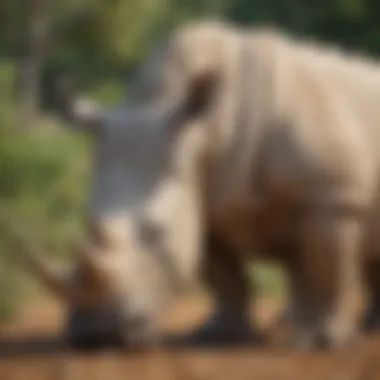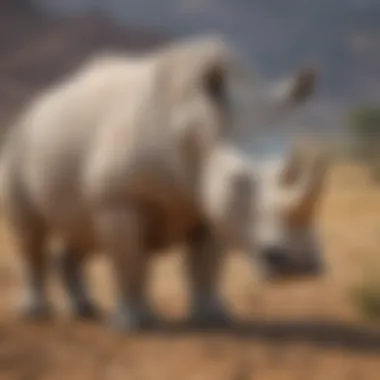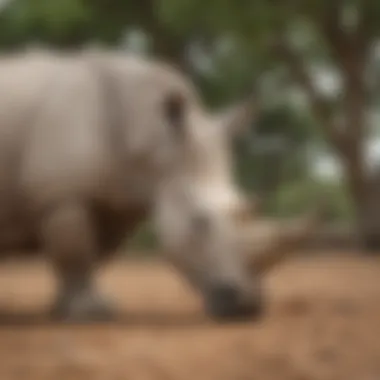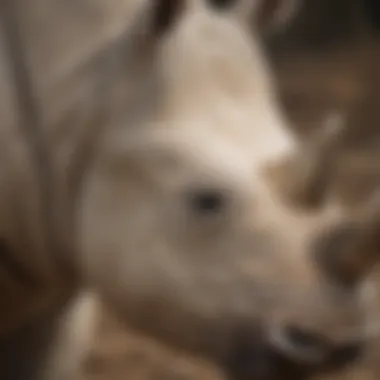The Northern White Rhinoceros: Population Status 2021


Intro
The northern white rhinoceros, a subspecies of the white rhinoceros, stands at the brink of extinction. In 2021, the population is reduced to only a few individuals, primarily residing in conservancies in Kenya. This situation is alarming and highlights the consequences of poaching and habitat loss. The story of the northern white rhinoceros reflects broader trends and challenges faced by many endangered species. Efforts to maintain this subspecies emphasize the critical need for conservation strategies skilled at addressing modern threats.
Animal Overview
Common Names
The common names for the northern white rhinoceros include northern white rhino and lesser white rhinoceros. These names help differentiate it from other subspecies, particularly the southern white rhinoceros.
Scientific Classification
The northern white rhinoceros belongs to the family Rhinocerotidae. Its scientific name is Ceratotherium simum cottoni. This classification places it within a group of unique large mammals that are vital parts of their ecosystems.
Geographic Range
Historically, the northern white rhinoceros roamed across parts of East and Central Africa. Specifically, these rhinos were found in countries such as the Democratic Republic of Congo, Uganda, and Sudan. Currently, their range is severely limited, with most of the remaining individuals concentrated in the Ol Pejeta Conservancy in Kenya.
Behavior and Social Structure
Social Behavior
Northern white rhinoceroses are generally solitary creatures. However, they can display social tendencies, especially females with calves. Their social structure is influenced by environmental factors, as well as the availability of resources.
Communication
Communication among northern white rhinoceroses involves vocalizations, body language, and scent marking. They may use calls to express distress or communicate proximity. This ability to communicate aids in their survival in natural habitats.
Mating and Reproduction
Mating among northern white rhinoceroses can be sporadic. Female white rhinos have a gestation period of about 16 months, with calves typically staying close to their mothers for several years. Sadly, the low reproductive rate, coupled with the nearly nonexistent population, poses significant challenges for the species' survival.
Habitat and Ecosystem
Natural Habitat
The northern white rhinoceros primarily inhabited grasslands and savannas, which provided them with the necessary resources for survival. These open areas allowed for grazing and movement, crucial for finding food and avoiding threats.
Food Sources and Diet
Northern white rhinoceroses are herbivores that feed mainly on grasses, especially the softer, more nutritious species. Their dietary preferences link directly to their habitat, emphasizing the importance of healthy ecosystems for their survival.
Role in Ecosystem
The northern white rhinoceros plays a critical role in its ecosystem. By grazing, this large herbivore helps maintain the grassland structure. Their behaviors contribute to the health and diversity of the environments they inhabit, supporting various other species.
The northern white rhinoceros is not just a symbol of conservation efforts. Its fate represents the delicate balance of biodiversity and the pressing threats posed by human activities.
Preamble to the Northern White Rhinoceros
The northern white rhinoceros holds a critical place in wildlife conservation discussions due to its alarming plight. Understanding this subspecies is essential for comprehending the broader issues related to extinction and biodiversity. This section provides a foundational overview, focusing on the northern white rhinoceros's unique characteristics and its role within ecosystems. Important aspects include its historical context, current population status, and the challenges it faces. Highlighting these elements helps illuminate the significance of ongoing conservation efforts and advocates for urgent action.
Historical Context


Historically, the northern white rhinoceros thrived across regions in East and Central Africa. In the late 19th and early 20th centuries, these animals were abundant. However, the extensive hunting for horns and habitat destruction began to decimate their numbers. By the 20th century, the northern white rhinoceros faced severe population decline. Factors such as poaching intensified, driven by the demand for rhino horns in traditional medicine and as status symbols. The last known wild populations were reported mainly in the 1980s.
A significant event in this history was the establishment of reserves and protected areas. Yet, these efforts often lacked effective enforcement, leaving the rhinoceros susceptible to illegal hunting. Those conservation initiatives raised awareness but did not reverse the downward trend quickly enough. By 2018, the world saw a dramatic moment. Only two individuals were confirmed alive: both females, named Najin and Fatu, thus marking the northern white rhinoceros on the brink of extinction.
Biological and Ecological Characteristics
The northern white rhinoceros has distinct biological features, contributing to its resilience in the wild. Adult males can weigh up to 2,500 kilograms, making them one of the largest terrestrial mammals. Their skin is thick and tough, providing protection against environmental elements and predators. Unlike their southern counterparts, northern white rhinos have a slightly different horn structure. They possess a broader mouth adapted to grazing on shrubs and grasses rather than browsing on trees.
From an ecological standpoint, this subspecies plays a pivotal role. They help maintain the ecosystem by controlling vegetation growth, which can prevent overgrazing and promote a diverse plant community. This interaction is vital for other species inhabiting their shared environments. As keystone species, the extinction of the northern white rhinoceros would significantly impact other wildlife and the habitats they rely on. Therefore, understanding their biology and role is crucial for conservationists striving to protect and revive the species.
Key Insight: The northern white rhinoceros is not just a unique species; it is also a crucial component of its ecosystem.
Current Population Status in
Understanding the current population status of the Northern white rhinoceros is crucial for conservation measures. This section serves as a foundation to analyze the critical challenges faced by this subspecies and the ongoing efforts for their survival. Knowledge of population numbers and genetic diversity provides insights into the viability of their future and highlights the urgency behind conservation action. In 2021, only two individuals, both female, are known to exist, deepening concerns regarding extinction.
Total Count of Northern White Rhinoceroses
As of 2021, the total count of Northern white rhinoceroses has reached a grim low of just two individuals, both residing in the Ol Pejeta Conservancy in Kenya. These two females, named Najin and Fatu, represent the last remnants of their kind. This unprecedented decline over the last century can be attributed largely to intensive poaching and habitat destruction. It underscores the alarming reality of subspecies extinction and the work yet to be done.
The dwindling population highlights the need for innovative approaches in conservation. Organizations are now focusing on advanced reproductive technologies, such as in vitro fertilization, to attempt to produce viable offspring. However, the immediate priority remains protecting Najin and Fatu from any potential threats, while simultaneously fostering awareness about their precarious situation.
Assessment of Genetic Diversity
Evaluating the genetic diversity of the remaining Northern white rhinoceroses is vital for their future. Genetic diversity is essential for the adaptability of a species. In 2021, the genetic pool of the Northern white rhinoceros has been nearly exhausted. With only two surviving individuals, there are serious concerns regarding inbreeding and its detrimental effects on health and reproduction. The lack of genetic variation can lead to increased vulnerability to disease and reduced fertility, further jeopardizing the chances of population recovery.
Scientists and conservationists are utilizing genetic research to assess the viability of existing DNA samples from deceased Northern white rhinos. This can potentially guide efforts in assisted reproductive technologies, aiming to expand genetic diversity through scientific intervention. The combined use of these methodologies is fundamental in efforts to ensure that the genetic legacy of the Northern white rhinoceros does not fade away entirely.
The fight for Northern white rhinos is not just about saving a subspecies; it's about preserving biodiversity and the balance of ecosystems that depend on such species for their health and stability.
Threats to the Northern White Rhinoceros
The northern white rhinoceros faces a myriad of threats that jeopardize its existence. Understanding these threats is crucial for several reasons. Firstly, they provide insight into the complexities of wildlife conservation in a broader sense. Secondly, by identifying specific challenges, stakeholders can develop targeted strategies to mitigate these threats. Lastly, recognizing these dangers raises awareness among the public and fosters a sense of collective responsibility towards preserving such a vulnerable species.
Impact of Poaching
Poaching remains one of the foremost threats to the northern white rhinoceros. The demand for rhinoceros horn, primarily driven by illegal markets in Asia, has led to significant declines in their population. The horns are falsely believed to have medicinal properties, which fuels hunting activities. Unfortunately, the northern white rhinoceros has been particularly vulnerable due to its already small population size.
Poaching not only reduces the number of individuals but also disrupts social structures within the species. The killing of rhinos affects related herd members and can lead to increased stress among surviving individuals. Additionally, the financial gains from poaching contribute to ongoing conflicts and instability in regions where these animals reside. Law enforcement efforts face challenges, and without rigorous anti-poaching initiatives, the future of this subspecies appears increasingly dire.
Habitat Loss and Fragmentation
Habitat loss and fragmentation also play a critical role in the decline of the northern white rhinoceros. Human encroachment, agricultural expansion, and urban development result in shrinking habitats for these majestic creatures. This encroachment leads to fragmented populations that struggle to find mates and resource availability. The survival of the northern white rhinoceros is intricately tied to its habitat, which must sustain their dietary needs and provide adequate shelter.
In addition, fragmented habitats increase the risk of isolation. When populations are cut off from each other, genetic diversity diminishes, making them more susceptible to diseases and less adaptable to environmental changes. The poorly connected areas discourage natural movement patterns, which can lead to a host of issues, from inbreeding to decreased reproduction rates.
Climate Change Implications
Climate change poses another serious concern for the northern white rhinoceros. Rising temperatures and shifting weather patterns can have direct consequences on the ecosystems these animals depend on. Altered precipitation patterns can lead to habitat degradation, affecting the vegetation that rhinos rely on for food. As droughts become more frequent and severe, food availability could be drastically impacted.
Moreover, climate change exacerbates the threats of habitat loss and fragmentation. As habitats change, they may no longer be suitable for the northern white rhinoceros, forcing them into smaller areas with more competition for resources. Additionally, as climates shift, other species may migrate into occupied regions, further stressing the rhino population.
“The combination of poaching, habitat loss, and climate change poses an existential threat to the remaining northern white rhinoceroses. Immediate and coordinated conservation efforts are essential.”
Conservation Efforts and Strategies


Conservation efforts for the northern white rhinoceros are crucial in reversing the trends leading to its near extinction. As of 2021, the situation is dire. With only two known female individuals left, these conservation strategies become more important than ever. They aim to protect existing individuals while attempting to restore population numbers. Efforts in conservation are varied and have distinct modalities, primarily focusing on in situ and ex situ strategies. These efforts hold particular significance as they encompass a combination of ecological needs, scientific advancements, and international cooperation.
In Situ Conservation Practices
In situ conservation involves protecting the natural habitat and current ecosystems where northern white rhinoceroses reside. This approach helps maintain their ecological role and preserves biodiversity. Conservationists strive to establish wildlife reserves, enforce anti-poaching policies, and ensure that adequate resources are available in these protected areas. Key practices include:
- Protected Areas: Establishing national parks such as the Ol Pejeta Conservancy in Kenya, where the last remaining northern whites are housed. This reserve serves not only as a safe habitat but also aims to create awareness and drive funding for ongoing protection efforts.
- Anti-Poaching Patrols: Employing trained rangers dedicated to tracking and preventing poaching incidents. This includes the use of surveillance techniques, sniffer dogs, and even community engagement to cultivate local stewardship.
In situ conservation remains the frontline defense against extinction. Its success largely relies on the sustainable management of funds and local communities' awareness regarding the importance of preserving the northern white rhinoceros.
Ex Situ Conservation and Breeding Programs
Ex situ conservation focuses on protecting the species outside its natural habitat, primarily through breeding programs. These strategies attempt to increase population numbers through controlled breeding. Some noteworthy components of this approach are:
- Assisted Reproductive Technologies: It includes techniques like in vitro fertilization and embryo transfers. Scientists are working diligently to create viable embryos using genetic material from deceased northern white rhinoceroses, thus maximizing the genetic diversity of the existing gene pool.
- Captive Breeding Facilities: These facilities serve as safekeeping for the two remaining females. The world is watching closely to see if these delicate technologies can yield results, perhaps enabling the reintroduction of more individuals back into the wild in the future.
Ex situ efforts show promise, yet they cannot wholly replace the importance of in situ strategies, as the ultimate goal is to re-establish a viable and self-sustaining population in its native habitat.
International Collaboration Initiatives
Global cooperation is necessary to ensure the survival of the northern white rhinoceros. The situation goes beyond national borders; it requires a unified front. International collaboration takes various forms:
- Scientific Research Partnerships: Collaborating between research institutions across continents enhances knowledge sharing. Such partnerships may lead to breakthroughs in breeding techniques or bolstered anti-poaching tactics.
- Funding and Resources: Many international NGOs provide critical financial resources for conservation actions. Initiatives like the World Wildlife Fund and Save the Rhino have been pivotal in gathering funds and raising awareness.
- Policy Advocacy: Working through international treaties, countries can create policies that facilitate successful conservation practices. These can include stricter regulations against wildlife trafficking and stronger penalties for poachers.
Through collective efforts, conservationists hope to pool knowledge, technology, and financial backing to deal with the challenges faced by the northern white rhinoceros population.
"The survival of the northern white rhinoceros hinges not just on breeding programs, but on a concerted global effort that integrates habitat protection, scientific advancement, and community involvement."
Technological Advances in Conservation
Technological advances play a critical role in the conservation of the northern white rhinoceros. As the numbers dwindle, embracing new tools provides essential support to ongoing efforts. These innovations allow for better monitoring, improved breeding strategies, and enhanced educational outreach. The integration of technology can lead to more effective use of resources, which is crucial when every individual rhinoceros counts.
Use of Drones and Surveillance Technology
Drones have emerged as a groundbreaking method in wildlife conservation. Their ability to cover vast areas quickly and efficiently makes them ideal for monitoring rhino populations and their habitats. With drones, conservationists can collect data on the movement patterns of these animals without intruding on their natural behavior. This data is invaluable for understanding their needs and creating protective measures.
For instance, drones are equipped with high-resolution cameras and thermal imaging systems. These tools help to detect poachers and monitor wildlife in real-time. Such surveillance is vital in areas where poaching remains a major threat. The information gathered allows rangers to respond swiftly to any illegal activities, effectively increasing the chances of protecting remaining northern white rhinos.
Benefits of Drones in Conservation
- Enhanced Surveillance: Drones can monitor large areas in a fraction of the time compared to traditional methods.
- Data Collection: They are capable of gathering crucial information on habitat conditions and animal behavior.
- Cost-effective: Reduces the need for manned patrols over vast, often difficult terrain.
Genetic Research and Assisted Reproductive Techniques
Advancements in genetic research have opened new avenues for the conservation of the northern white rhinoceros. Since the population has severely declined, maintaining genetic diversity is crucial. Technologies such as genomic sequencing enable scientists to understand genetic variations among existing rhinos. This knowledge is essential in guiding breeding programs to avoid genetic bottlenecks.
Assisted reproductive techniques, including in vitro fertilization (IVF), are being utilized to aid in breeding efforts. Scientists can use oocytes from female northern white rhinos and fertilize them using sperm from deceased males. This process enhances the probability of successful breeding, allowing for a potential increase in population numbers. Additionally, techniques like cryopreservation help preserve genetic material from both living and deceased rhinoceroses, ensuring future breeding possibilities.
Importance of Genetic Research
- Maintaining Diversity: Genetic diversity is vital for the long-term survival of the subspecies.
- Informed Breeding Choices: Data-driven decisions enhance breeding success rates.
- Resilience Against Disease: A genetically diverse population can better withstand diseases.
Ultimately, the use of technology in conservation provides a beacon of hope in the face of impending extinction for the northern white rhinoceros. By employing drones for surveillance and advancing genetic research and reproductive techniques, conservationists are better equipped to navigate the complexities of saving this rare subspecies.
The Role of Global Awareness and Advocacy


The plight of the northern white rhinoceros highlights a broader conversation about conservation. Awareness and advocacy are crucial in the fight against extinction. They create a platform that fosters understanding of the issues surrounding the survival of this unique subspecies. Raising awareness can draw attention to the urgency of the situation. This affects not only the northern white rhinoceros but many species facing similar challenges.
Successful advocacy can lead to increased funding for conservation efforts. When the public understands the significance of biodiversity, they are more likely to support initiatives aimed at preserving habitats and protecting endangered species. Engaging communities through education fosters a sense of stewardship towards wildlife. People are more inclined to participate in conservation activities when they feel informed.
Public Engagement and Education
Public engagement is fundamental for the survival of the northern white rhinoceros. Education programs can enlighten audiences about the species' struggles. Schools, wildlife organizations, and media can work together to disseminate information effectively. Initiatives like wildlife awareness days or collaborative events can boost public interest.
Approaching education with a focus on the implications of losing such a species can provoke emotional responses. When people learn about the consequences of extinction, they tend to feel a connection to the issue. This emotional connection can lead to individual action and community involvement.
Various platforms, such as social media and workshops, help spread knowledge. The involvement of influencers can dramatically amplify these messages, engaging segments of the population that may not be aware of the situation. Social media campaigns can illustrate the importance of conservation, making it more relatable to the general populace.
Philanthropic Contributions and Support
Philanthropy plays a critical role in conservation efforts for the northern white rhinoceros. Donations and grants can finance research, protection measures, and breeding programs. Several organizations focus on wildlife conservation and rely on the generous support of private donors and foundations.
Financial contributions can also enhance the effectiveness of conservation strategies. They enable organizations to develop new methods for monitoring populations or combating poaching. Without sufficient funding, many initiatives may falter, leading to a decline in efforts to save these rhinos.
Building partnerships between nonprofit organizations and corporations can create a sustainable model for financial support. Collaborative campaigns can raise funds while also increasing visibility for the cause. Consistent communication about where funds go and the impact they create is essential in maintaining donor trust.
In summary, global awareness and advocacy are pivotal in conserving the northern white rhinoceros. They serve as a catalyst for change, driving public interest, enhancing education, and securing vital funding. Without these efforts, the future of this subspecies remains uncertain.
Future Prospects for the Northern White Rhinoceros
The future of the northern white rhinoceros is a subject of intense scrutiny and concern, especially as the year 2021 presents a pivotal juncture for this critically endangered subspecies. Acknowledging the factors that shape its survival is essential to promote awareness and action. The discussion here revolves around specific challenges anticipated in the near future and the avenues for resilience that may allow the species to endure. It is crucial for researchers, conservationists, and the public to understand these elements, as they collectively impact conservation policies and practices.
Predicted Challenges Ahead
Looking forward, the northern white rhinoceros faces numerous hurdles. Some key challenges include:
- Continued Risk of Poaching: While various efforts have been made to curb poaching, it remains a significant threat. Demand for rhino horn persists, stimulating illegal hunting.
- Loss of Habitat: Urban development and agricultural expansion continue to encroach upon the natural habitats of these animals. This contributes to fragmentation, decreasing the land available for foraging and breeding.
- Genetic Bottleneck: With only two known individuals in the subspecies, the genetic diversity is alarmingly low. This limits the ability to adapt to environmental changes and increases vulnerability to disease.
- Funding for Conservation: Maintaining ongoing conservation efforts requires substantial financial resources. As priorities shift in the global landscape, securing adequate funding remains a critical concern that could affect future initiatives.
Together, these challenges create a complex scenario that risks further decline of the population.
Hope and Resilience: A Path Forward
Despite the bleak outlook, there remains a glimmer of hope for the northern white rhinoceros. Several proactive measures and strategies could pave the way for a more secure future:
- Advanced Breeding Techniques: The application of assisted reproductive technologies may facilitate the reproduction of the remaining individuals. Techniques like in vitro fertilization are being explored to increase genetic diversity.
- Strengthened Anti-Poaching Efforts: Enhanced surveillance and patrols, often supported by technology like drones, could significantly reduce poaching incidents. Efforts in community engagement often yield positive results, as locals become more involved in protecting their wildlife.
- Global Collaboration: The future of the northern white rhinoceros depends on international cooperation. Environmental organizations, governments, and local communities must work together to create and sustain effective conservation strategies.
- Public Awareness Campaigns: Enhancing knowledge about the plight of the northern white rhinoceros can foster a broader base of support for conservation. Education can lead to increased advocacy and funding, which are vital for recovery efforts.
In light of these considerations, there is a potential path forward marked by innovation, collaboration, and commitment. The resilience of this species may hinge on our collective actions in the upcoming years.
Closure
The conclusion section serves as a vital component of this article, summarizing key finds and fostering a strong call to action. This part deliberates the critical nature of addressing the challenges surrounding the northern white rhinoceros. It reflects on the precarious state of population numbers and underscores how interconnected the fate of this species is with broader ecological health.
Recap of Key Insights
The northern white rhinoceros stands at a brink of extinction, with only two known individuals remaining, both female. This stark reality has prompted a myriad of conservation strategies aimed at preventing loss of genetic diversity and ensuring possible future breeding efforts. Significant threats include poaching for their horns, habitat loss due to human encroachment, and climate change, which exacerbates these challenges.
However, the global awareness brought forth by various organizations and individuals has fostered new conservation policies and initiatives. Awakening a sense of responsibility towards biodiversity emphasizes the importance of protecting not just the northern white rhinoceros but a broader spectrum of wildlife. The resilience shown by conservationists reaffirms that every action potentially contributes to a more balanced ecosystem.
Call to Action for Conservation
The responsibility for the northern white rhinoceros does not rest solely on the shoulders of conservationists; it is a global challenge that necessitates unified efforts. Individuals can play a critical role by furthering their understanding of wildlife conservation issues.
Recommendations for Actions:
- Support wildlife conservation organizations financially or through volunteering.
- Advocate for stricter anti-poaching laws and protection policies.
- Encourage environmental education in local communities to foster appreciation and protection of wildlife.
- Spread awareness through social media platforms to inform others about the threats faced by species like the northern white rhinoceros.
Working collectively not only benefits this particular species but also enriches ecosystem health worldwide. The preservation of the northern white rhinoceros can inspire impactful legacies for future generations. Your involvement could be a crucial part of this endeavor.







